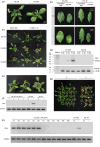Characterization of genetic resistance to cucumber mosaic virus (CMV) in spinach (Spinacia oleracea L.)
- PMID: 39533390
- PMCID: PMC11559168
- DOI: 10.1186/s13104-024-06987-2
Characterization of genetic resistance to cucumber mosaic virus (CMV) in spinach (Spinacia oleracea L.)
Abstract
Objective: Cucumber mosaic virus (CMV) is a significant pathogen causing quality loss in spinach. Although host genetic resistance is the primary method of managing CMV infection in this crop, CMV resistance genes are not widely utilized in spinach breeding programs as the genetic and molecular mechanisms underlying resistance are not yet fully understood. CMV infections were therefore studied in different lines of spinach plants, and their progeny, to develop a model of the genetic basis of CMV resistance.
Results: Visual observations and RT-PCR assays revealed that three monoecious lines (03-258, 03-263, and 03-336) were susceptible to CMV, while three traditional resistant cultivars and a near-isogenic line (NIL-M) exhibited resistance. A dioecious line (03-009) consisted of susceptible and resistant plants. Notably, resistant plants did not exhibit the lesions typical of the hypersensitive response. Genetic analysis of progeny from the cross NIL-M × 03-336 indicated that a single dominant allele (designated SRCm1, standing for Spinach Resistance to CMV 1) controlled CMV resistance; analysis of sib-cross progeny populations derived from line 03-009 supported this conclusion. These results offer a valuable model for CMV resistance in spinach and will enhance future breeding programs.
Keywords: Spinacia oleracea; Cucumber mosaic virus; Extreme resistance; Hypersensitive resistance; Spinach.
© 2024. The Author(s).
Conflict of interest statement
Figures

References
-
- Zitter TA, Murphy JF. Cucumber Mosaic. The Plant Health Instructor 2009.
-
- Roossinck MJ. Cucumber mosaic virus, a model for RNA virus evolution. Mol Plant Pathol. 2001;2(2):59–63. - PubMed
-
- Morelock TE, Correll JC. Spinach. In: Vegetables I: Asteraceae, Brassicaceae, Chenopodicaceae, and Cucurbitaceae. Edited by Prohens J, Nuez F. New York, NY: Springer New York; 2008: 189–218.
-
- Pound GS, Cheo PC. Studies on resistance to cucumber virus I in spinach. Phytopathology. 1952;42:301–6.
-
- Koike ST, Becker JO, Smith RF, Fennimore SA, LeStrange M. UC IPM Pest Management guidelines: spinach. Volume 3467. Davis, CA: UC ANR Publication; 2012.
MeSH terms
Grants and funding
LinkOut - more resources
Full Text Sources

